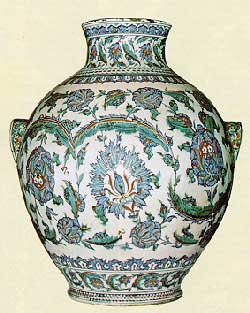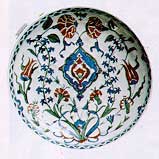|
|
|
Second half of the 16th century Iznik Ceramics The tiles at the corner where the sultans made their prayer, in the Selimiye Mosque, Edirne. Made in Iznik in 1575 Second half of the 16th century which is named as the classical age of Turkish art during Ottoman rule, was the most magnificent period for ceramics as well as the other handcrafts. The white paste products in ceramics which had started with the Blue-and-Whites had reached the summit of their developmental phases during 1549. The three lugged lamp, which originally belonged to the Omar Mosque in Jerusalem and which is now displayed in the British Museum, bears the production date and place on the inscription panel on its pedestal. This inscription reads Iznik -1549. The most important final phase of the Turkish ceramic art also started with a three lugged lamp made for the Süleymaniye Mosque, Istanbul which was completed in 1557. This example is on display in the Victoria and Albert Museum, London. One of the richest collections of the world related to that period is kept in the Tiled Kiosk, Istanbul which has been converted into the Museum of Turkish Building Tiles and Ceramics. This third stage of our building tile and ceramic art continued until 1608. Iznik workshops applied underglaze technic during this period of extraordinary success which started with the Blue-and-Whites. This period attained a unique level in worldwide tile and ceramic art with its design and colour scale. The geometrical design of the Seljuk inheritance was completely dispensed with in the embellishments whereas the palmettes and leaves were still used. The plant motifs of the classical age were drawn on the white undercoats. A superficial abstraction is dominant in the naturalistic plant designs. The main examples of Nature motifs were carnations, tulips, plum blossoms and branches in full blossom, pomegranates, peonies, broken leaves, rosettes, roses, bunch of grapes, acanthus leaves, vases and birds with black, thin countermines. Pottery dish decorated with tulip, carnation, hyacinth, rose and leaf motifs. Iznik, 2nd half of the 16th century. The colour scale on the artist's palette reached to seven different values with their various tones. The white, tile paste prepared with a great amount of silica is given form on the pottery lathe, then it is dried in the sun and baked in the oven at a degree of 800-1000+C. When it cools, a white, thin kaolin undercoat is applied. The decorations are drawn and coloured on this undercoat and then it is reovened to fix the colours. It is then glazed with thin, transparent lead-glass and the final baking takes place. The cobalt or sead blues, turquoises, manganese violets, chrome greens, slightly raised coral and tomato reds and their various tones on white ground which are painted underglaze, give a colour drunkenness to the admirers as well as the artist himself. There are no cracks on the glaze. Motion and dynamism are in full balance and symmetry both in the designs and the colours. Each motif is a whole in itself whereas it is also an unseparable part of the eternal whole. Celi and Nesih styles of calligraphy are often seen in these embellishments. Jar decorated with pomegranade blossoms, leaves, and peonies on white ground. Iznik, 2nd half of the 16th century. 65 cm tall. The decorated surfaces of the Ottoman polychrome pottery made by underglaze technic are embellished with white and pale blue over either indigo or light brown. They are made with raised and coloured undercoat and black underglaze colouring is also seen. Thus, they have a special characteristic with these qualities. The coloured undercoat decoration technic under transparent, colourless glaze, has been successfully applied in building-tiles as well as pottery, as can be witnessed by an example displayed in the Tiled Kiosk Museum, Istanbul. This technic is another development of that period. According to documents and books giving information about that period, forty five of the sixhundred artists working for the court were painters and designers. The composition of decorations to be applied on the inner or outer surfaces of artistic architectural works were prepared by those artists. The preliminairy sketches were presented to the court by means of the head architect and the necessary approval was obtained. Imperial edicts and orders take place among the archives documents related to the Iznik tile workshops. In these documents dated 1575, 1578, 1588, not only the list of ordered products, but also the inventory of the tiles and pottery stocked in the depots are mentioned. Furthermore the names of the production supervisors and the artists are also written. The workshops that gave priority to the orders of the court and its close circles were more than 300 during that period. Those workshops met from time to time the demands for export and the foreign orders. The export port was Lindos in Rhodes. Some European researchers have been misled by the Rhodes stamps on the ceramics and they have mentioned these as Rhodes tiles and pottery in their publications. Some of these ceramics also bear the coats of arms of foreign families. It is understood from the samples that in addition to the Iznik production center, the workshops in Kütahya and Haliç, Istanbul successfully produced ceramics. The recession in Iznik and the decadence of the workshops started in the beginning of the 17th century. The colours lost their vividness. The coral and tomato blues darkened. Quality deficits and cracks on the glazes began. The attractiveness was lost. The net lines of the contours were dispersed. The political regression was felt most at the Iznik tile workshops among all the handcrafts. The decadence was completed when financial support ceased and the producer families were scattered away. The later attempts to revive did not give successful results. The level of the second half of the 16th century was never attained. Since the production technic details were kept secret, and the technical development knowledge was not mentioned in written documents, an important gap of information was formed for the following generations. The attempts for revival required thoroughly new efforts and these efforts could not be a substitution for the traditional training passing from one generation to the next. The examples to be found in the museums and in private collection/gain value and they are considered rare works of art in the world antique markets. Source: Antika, The Turkish Journal of Collectable Art, October 1985, Issue 7 By: Can Kerametli |
DECORATIVE ARTS IZNIK SERAMICS |

